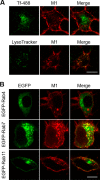The serotonin transporter undergoes constitutive internalization and is primarily sorted to late endosomes and lysosomal degradation
- PMID: 24973209
- PMCID: PMC4132800
- DOI: 10.1074/jbc.M113.495754
The serotonin transporter undergoes constitutive internalization and is primarily sorted to late endosomes and lysosomal degradation
Abstract
The serotonin transporter (SERT) plays a critical role in regulating serotonin signaling by mediating reuptake of serotonin from the extracellular space. The molecular and cellular mechanisms controlling SERT levels in the membrane remain poorly understood. To study trafficking of the surface resident SERT, two functional epitope-tagged variants were generated. Fusion of a FLAG-tagged one-transmembrane segment protein Tac to the SERT N terminus generated a transporter with an extracellular epitope suited for trafficking studies (TacSERT). Likewise, a construct with an extracellular antibody epitope was generated by introducing an HA (hemagglutinin) tag in the extracellular loop 2 of SERT (HA-SERT). By using TacSERT and HA-SERT in antibody-based internalization assays, we show that SERT undergoes constitutive internalization in a dynamin-dependent manner. Confocal images of constitutively internalized SERT demonstrated that SERT primarily co-localized with the late endosomal/lysosomal marker Rab7, whereas little co-localization was observed with the Rab11, a marker of the "long loop" recycling pathway. This sorting pattern was distinct from that of a prototypical recycling membrane protein, the β2-adrenergic receptor. Furthermore, internalized SERT co-localized with the lysosomal marker LysoTracker and not with transferrin. The sorting pattern was further confirmed by visualizing internalization of SERT using the fluorescent cocaine analog JHC1-64 and by reversible and pulse-chase biotinylation assays showing evidence for lysosomal degradation of the internalized transporter. Finally, we found that SERT internalized in response to stimulation with 12-myristate 13-acetate co-localized primarily with Rab7- and LysoTracker-positive compartments. We conclude that SERT is constitutively internalized and that the internalized transporter is sorted mainly to degradation.
Keywords: Cellular Regulation; Endocytosis; Intracellular Trafficking; Monoamine Transporter; Protein Kinase C (PKC); Protein Sorting; Serotonin Transporter.
© 2014 by The American Society for Biochemistry and Molecular Biology, Inc.
Figures










Similar articles
-
Postendocytic sorting of constitutively internalized dopamine transporter in cell lines and dopaminergic neurons.J Biol Chem. 2010 Aug 27;285(35):27289-27301. doi: 10.1074/jbc.M110.131003. Epub 2010 Jun 15. J Biol Chem. 2010. PMID: 20551317 Free PMC article.
-
Differential Internalization Rates and Postendocytic Sorting of the Norepinephrine and Dopamine Transporters Are Controlled by Structural Elements in the N Termini.J Biol Chem. 2016 Mar 11;291(11):5634-5651. doi: 10.1074/jbc.M115.702050. Epub 2016 Jan 19. J Biol Chem. 2016. PMID: 26786096 Free PMC article.
-
Serotonin-induced down-regulation of cell surface serotonin transporter.Neurochem Int. 2014 Jul;73:107-12. doi: 10.1016/j.neuint.2014.01.005. Epub 2014 Jan 22. Neurochem Int. 2014. PMID: 24462583 Free PMC article.
-
Rab GTPase Function in Endosome and Lysosome Biogenesis.Trends Cell Biol. 2018 Nov;28(11):957-970. doi: 10.1016/j.tcb.2018.06.007. Epub 2018 Jul 17. Trends Cell Biol. 2018. PMID: 30025982 Review.
-
The nature of the binding between insulin receptor and serotonin transporter in placenta (review).Placenta. 2023 Mar 3;133:40-44. doi: 10.1016/j.placenta.2023.02.001. Epub 2023 Feb 6. Placenta. 2023. PMID: 36796293 Review.
Cited by
-
Deficiency of Rab26 causes behavioral defects in mice through impaired trafficking of serotonin (5-HT) transporter.iScience. 2025 Jun 18;28(7):112931. doi: 10.1016/j.isci.2025.112931. eCollection 2025 Jul 18. iScience. 2025. PMID: 40687824 Free PMC article.
-
Brain serotonin transporter binding, plasma arachidonic acid and depression severity: A positron emission tomography study of major depression.J Affect Disord. 2019 Oct 1;257:495-503. doi: 10.1016/j.jad.2019.07.035. Epub 2019 Jul 5. J Affect Disord. 2019. PMID: 31319341 Free PMC article.
-
Tales of tails in transporters.Open Biol. 2019 Jun 28;9(6):190083. doi: 10.1098/rsob.190083. Epub 2019 Jun 19. Open Biol. 2019. PMID: 31213137 Free PMC article. Review.
-
Rab4A-directed endosome traffic shapes pro-inflammatory mitochondrial metabolism in T cells via mitophagy, CD98 expression, and kynurenine-sensitive mTOR activation.Nat Commun. 2024 Mar 22;15(1):2598. doi: 10.1038/s41467-024-46441-2. Nat Commun. 2024. PMID: 38519468 Free PMC article.
-
Targeting SERT promotes tryptophan metabolism: mechanisms and implications in colon cancer treatment.J Exp Clin Cancer Res. 2021 May 18;40(1):173. doi: 10.1186/s13046-021-01971-1. J Exp Clin Cancer Res. 2021. PMID: 34006301 Free PMC article.
References
-
- Chen N. H., Reith M. E., Quick M. W. (2004) Synaptic uptake and beyond: the sodium- and chloride-dependent neurotransmitter transporter family SLC6. Pflugers Arch. 447, 519–531 - PubMed
-
- Kristensen A. S., Andersen J., Jørgensen T. N., Sørensen L., Eriksen J., Loland C. J., Strømgaard K., Gether U. (2011) SLC6 neurotransmitter transporters: structure, function, and regulation. Pharmacol. Rev. 63, 585–640 - PubMed
-
- Yamashita A., Singh S. K., Kawate T., Jin Y., Gouaux E. (2005) Crystal structure of a bacterial homologue of Na+/Cl−-dependent neurotransmitter transporters. Nature 437, 215–223 - PubMed
Publication types
MeSH terms
Substances
Grants and funding
LinkOut - more resources
Full Text Sources
Other Literature Sources

